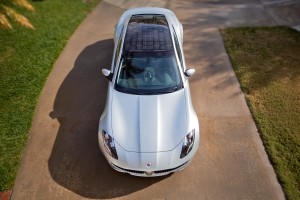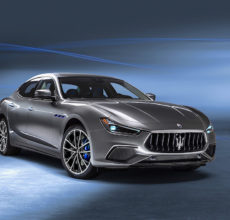Its formidable presence could snatch the limelight from a Maserati. In its cabin layout, it demands a nod from a Fortune 500 Chief Executive. But it is in the way it engages an imaginative mind in fantasies of the future that the Fisker Karma commands its half a million dirhams’ worth – meet the hybrid car for the puritan.

Fisker Karma is one of TIME Magazine’s Top 50 Innovations of 2012. In winning Fast company magazine ‘innovation by design award’, it left behind the Boeing 787 airliner, the Faraday bike and the Ford Fusion.
UPSIDE: Super car design, Stealth mode sound, elegant and eco-friendly interiors, Extended range with gas, reassuring drive
FLIPSIDE: Electric charge drains quickly with speed, Lack of gizmos for a future car, Occasional weight drag
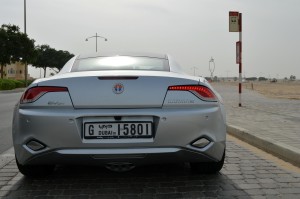
Fisker Karma is driven at all times by electric power. A 2L Front engine also turns the turbines that charge the generator. Two rear electric motors, rear-wheel drive, 1-speed direct drive transmission, doors four, seats four
The Drive
The Fisker Karma carries the badge of a sports car way beyond its formidable looks. With a wheelbase that is 124.4 long, this heavy car is as stable as you want your stallion to be. However, the paddle shifts behind the steering serve for nothing further than switching between the sport and stealth modes (it’s that easy by the way) and to be better equipped for a hill run.
The 80 km electric range that Fisker claims tends to dip by almost half even at marginally higher speeds than easy cruising. Watching the quickly disappearing quanta of electric charge on the screen, I was thankful that the car had an extended range of 400 km extra using its gas component. As I struggled to get past 120 kmph on the speedo, I recognized another good reason to reserve the sport mode for highways. In fact, which is why Fisker wisely recommends the maximum use of the electric mode within the city at around 60 – 80 kmph, so that you end up letting out less pollutants – be it sound or substance!
The Fisker Karma rides on 22” F1 tyres and stops with what else – Brembo brakes! While they are in character with its sporty mould, the flipside is that on your daily drive to office, anything short of glass-smooth roads can be somewhat uncomfortable.

Riding on smaller wheels could have worked out well but for the fact that anything less than 21”wheels would bring the car too close to the ground for comfort.
The design of the Karma offers excellent surrounding view besides looking nicely sporty. The car handles as balanced as a sport car but occasionally makes its stupendous weight felt in a bit of understeer. Nevertheless, what remained with me at the end of the road were the stable feeling and the responsive drive of the Karma.
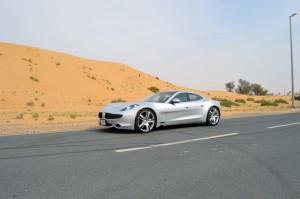
As for acceleration, the 0-100 kmph came up in 9 sec in the electric mode while shifting to sport mode brought up the mark in 7.3 sec on my drive.
Cabin and Controls
For a futuristic car, the controls in the Fisker Karma are almost too simple to believe. But then, isn’t the future supposed to make life less complicated? Reaching out to the graphic helix on the screen, I chose my preferred radio station quite like choosing coordinates on an electronic lattice. The large touch screen displays pretty much everything you need – from the cabin climate and radio frequency to vital information like the source of power at the moment, how much of energy you are saving and how much remains.

The Fisker Karma has a signature of refinement in the material that drapes the cabin. They are earth-friendly too.
The Karma opens its four doors to the command of press buttons, while the PNDR buttons on the console are as simple as a gearshift gets. But when you are given to believe that you are driving the car of the future, you tend to look beyond voice command options for media, climate control and vehicle systems.
The design philosophy of the man behind the Z8, the DB9 and the Vantage 8 has also evolved with time. Henrik Fisker seems to insist that car should not only answer the call of its driver but the calling to be earth-friendly. The natural texture of wood trims in the Karma’s cabin isn’t the usual super-smooth lacquer finish kind of thing. The wood comes from sunken or fallen Michigan trees just like the leather or the faux-suede seats and door side trims comes from recycled or recyclable material.
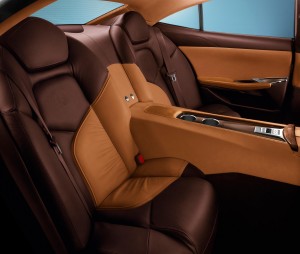
The long console that splits the luxurious cabin and the seats, as in the Panamera, qualifies the car as an executive four-seater.
While a CEO might be happy about having space for his golf clubs in the boot, he might overlook the rear seat because even as the legroom is ample for a sport car, it is slightly cramped for a car of this length and luxury sedan standards.
The Design
The Fisker Karma flaunts a design that, from different angles for different people, would bring elements of Aston Martin, Maserati and a BMW sportster to mind. The flared arches, rear ramparts and the gracefully aggressive grille make it look doubtlessly muscular and the car has the bulk to warrant it – 2400 kg of curb weight almost beats the new Aluminium cast Range Rover! Which should explain why the super car torque doesn’t convert entirely to super car velocities. The Fisker does provide some light entertainment for the already awe-struck driver behind with its dancing LED lights.
The H-Factor
Created by the genius of Henrik Fisker, styling that turns heads isn’t a surprise at all. But what is fascinating is what turns the turbines. Two electric motors that produce 153 kW each drive the wheels while a 2 L petrol engine sourced from GM turns the generators which, in turn, charges the Li-ion battery pack proudly showcased under the console glass. Now, if those numbers fail to draw a gasp, how about more familiar stuff? The Karma produces 403 bhp of power and 1300 Nm of torque, second only to the Bugatti Veyron in the latter.
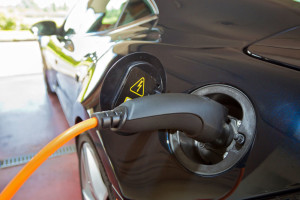
In the not-so-distant future, garages will have plug-in sockets for the hybrid, just like kitchens have for refrigerators.
It doesn’t have a sunroof but keeps the sun on the roof. The roof solar panels charge the electric turbines, though the savings become noteworthy only on an annual energy balance sheet. 12 hours of sunbathing a day would make for about 360 km a year – quite literally, a penny a day thing! However, in this part of the world, they serve a greater purpose. Even after you leave the car, the panels keep charging the fans, helping the engine to cool down and the cabin to maintain a pleasant climate.
The Sci-fi Karma
The sound of a sports car is what turns heads even before it is seen. Fisker Karma has a ‘futuristic silence’ that marks its stealth mode, which is both compensated and enhanced by Hollywood-style sound reproduction. Yet, when it comes to the sports mode, the engine produces a CVT like mono-tone drone which I found to be in no way intrusive at any time, but again not particularly exciting unlike the car itself. Now, this is simply because the car doesn’t have a traditional tranny and runs all the way up on its precise one-speed direct drive.
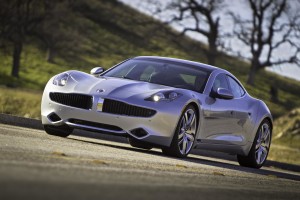
A recent US regulation stipulates that hybrid cars make some noise – so that they don’t turn up as an unpleasant surprise to unsuspecting pedestrians. Fisker Karma sets an example.
The mission of designing the Fisker Karma consisted of choosing the sound that is befitting to a futuristic transporter, appropriately aided by creators of auditory thrills for movies like star wars.
In fact it sounds nothing like a car when you are on stealth mode. Especially when the Karma gracefully took off or whistled its way to a stop, I was reminded of an aircraft preparing to taxi, or winding down its propellers! This is a car virtually designed by DC comics, Sci-fi designers and sound engineers of Hollywood – and of course Henrik Fisker.
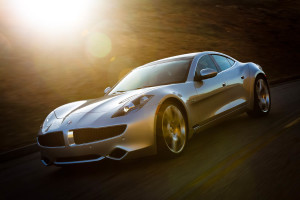
DRIVE MOTORS: AC permanent-magnet synchronous; 402 hp, 1300 Nm / GENERATOR ENGINE: turbocharged and intercooled DOHC 16-valve 2.0-liter inline-4, 260 hp, 353 Nm / GENERATOR: AC permanent-magnet synchronous, 235 hp
The Essential Fisker Karma
The Fisker Karma is certainly not the fastest or the quickest sports car you will drive. But as I would put it, it is a luxury car with a sporty heart and a pure soul.
Drive Courtesy: Trading Enterprises
Camera: Altas / Sudeep



